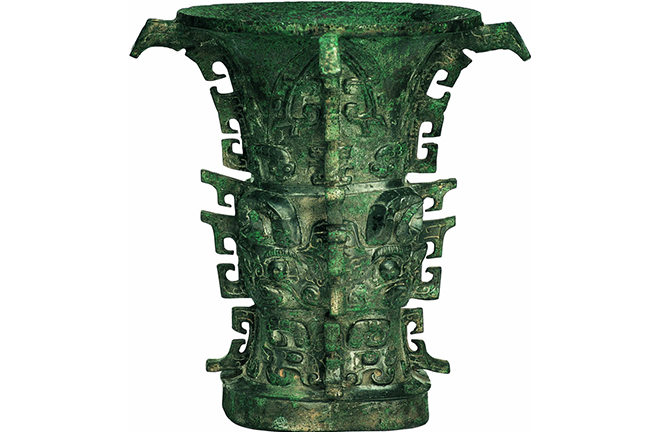Archaeology of Traditional Industry helps reveal origin of civilization

FILE PHOTO: The He Zun, an ancient Chinese ritual bronze vessel crafted around 3,000 years ago, is by far the oldest artifact with written Chinese characters meaning “Middle Kingdom,” the Chinese name for “China.”
The origin of human civilization is a question no easier to answer than the origin of the universe. For centuries, academics have discussed the elements of civilization—cities, metals, and writing systems. Under the guidance of historical materialism, archaeology is more inclined to understand the process of the origin of civilization from human societies’ degree of complexity.
“In the prehistoric era, especially when the social complexity process began at the end of the era, the development of productive forces was mainly manifested in the two fields of agriculture and traditional industry,” said Bai Yunxiang, a research fellow from the Institute of Archaeology at the Chinese Academy of Social Sciences. Technologies, production, the economy, organization, and management concerning traditional industry are both signs and driving forces of social complexity. As such, research on traditional industry is an important field for the study of the origin of civilization.
Emergence of the archaeological branch
Since the 1950s, archaeological research on relics of traditional industry, such as prehistoric pottery kiln sites, bronze smelting sites in the Shang (c. 16–11th century BCE) and Zhou (11th century–221 BCE) dynasties, ironware smelting sites in the Warring States Period (475–221 BCE), Qin (221–206 BCE) and Han (202 BCE–220 CE) dynasties, and porcelain kilns in successive dynasties following the Wei and Jin (220–420) period, has accumulated significant materials for case studies in ancient traditional industry. However, archaeological research of ancient traditional industry had not yet formed an effective synergy, let alone a system.
The turning point occurred in the late 1990s. Bai recalled that the focus of archaeological research in China gradually shifted from discovery and accumulation of archaeological data, and the construction of archaeological cultural temporal and spatial frameworks, to archaeological research of social history, and archaeological research of the origins and evolution of Chinese civilization.
In this context, based on the academic accumulation of case studies over the years, Bai published the article “The Essentials of Archaeology of Traditional Industry” in 2012, proposing the concept and proposition of “Archaeology of Traditional Industry.” A total of 25 major categories of ancient traditional industry, including stone tool industry, jade processing industry, the pottery industry, as well as bone, horn, and clam tool processing industry, are included as the research objects of this archaeological branch. The article also offers a preliminary comprehensive discussion on the Archaeology of Traditional Industry’s definition, research content, and research methods, which provides a theoretical basis for systematic research.
“One of archaeology’s basic research objects is cultural relics, and cultural relics are mostly products of traditional industry. Therefore, archaeology has a unique disciplinary advantage in the study of ancient traditional industry,” Bai said.
Almost synchronized with human beings’ origins, traditional industry began even earlier than agriculture. Liu Haiwang, director of the Henan Provincial Institute of Cultural Heritage and Archaeology, said that the birth of primitive pottery and stone grinding technology is a sign of the development of human society from the Paleolithic Age to the Neolithic Age, and it propelled the transition from collection to large-scale artificial cultivation of herbs and fruits consumed by humans, which is the emergence of primitive agriculture.
Commonalities and special features
Liu said that dividing human history into stages, such as the Stone Age, Copper-Bronze Age, and Iron Age, illustrates primitive society’s development process through the evolution of production tools and living utensils. This is highly scientific and generally accepted by the international archaeology community.
“The metallurgical industry, mainly involving copperware and ironware production, gradually dominated the development process of the ancient economy and society, and the iron smelting industry played a particularly significant role in supporting the development of the whole society,” Liu said.
According to Liu’s investigation, in addition to iron, eight kinds of non-ferrous metals were involved in the ancient metallurgical system. Among them, the earliest discovered are copper and gold, followed by silver, lead, tin, mercury, semi-metal arsenic, and finally zinc. These metals constitute the scope of metal research in metallurgical archaeology, involving the discovery, mining, smelting, and use of metals. Metallurgical archaeology, in a broad sense, involves the economy, technology, politics, military, culture, ideologies, beliefs, and many other aspects of society at that time.
Processing stone tools, the firing process for making pottery, and the invention of metallurgy, constitute an important reference for prehistoric culture and origin of civilization in ancient societies. Chinese civilization not only reflects the commonality of civilization in these traditional industry fields, but also unique features.
“China is among the earliest countries in the world to process and use jade,” Bai said, adding that the specialization of jade processing accelerated the specialization of the division of social production, and promoted social complexity. Jade also became the embodiment of social status for a specific class—and a symbol of power.
The emergence and intensification of specialization in traditional industry is an important factor driving the emergence and development of the state. For example, Wang Qing, a professor from the School of History and Culture at Shandong University, said that the salt industry was an important sector of ancient traditional industry in China and an important manifestation of specialization in traditional industry. Social behaviors around the production and distribution of salt are also significant forces driving social evolution.
Edited by JIANG HONG

 PRINT
PRINT CLOSE
CLOSE